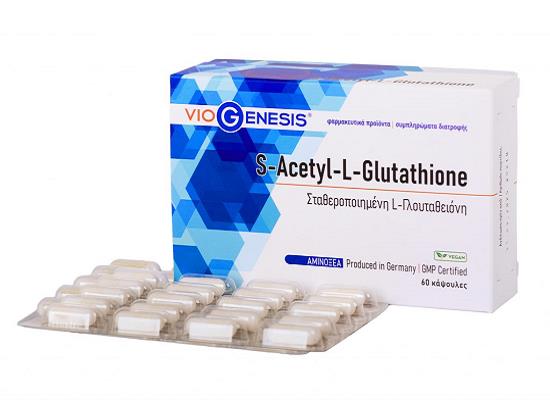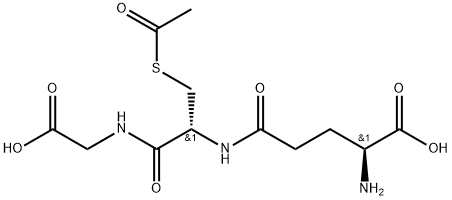S-Acetyl-L-glutathione: activities and applications
Oct 23,2023
General Description
S-Acetyl-L-glutathione is a modified form of the natural antioxidant glutathione and has demonstrated significant potential in various areas of health. In inducing apoptosis in human lymphoma cells, Sag has shown to selectively activate programmed cell death in sensitive cell lines, providing evidence for its potential as a new inducer of lymphoma cell apoptosis. Additionally, it has demonstrated antioxidant activity, particularly in liver disease progression, by increasing intracellular glutathione levels and improving various liver markers. S-Acetyl-L-glutathione's ability to replenish glutathione levels makes it beneficial in supporting healthy aging and promoting cellular function while also aiding in improving liver function and enhancing immune response. Overall, S-Acetyl-L-glutathione is a valuable compound with diverse applications, showing promise in potential therapeutic utility for lymphoma patients and clinical management of liver diseases in canines, and supporting overall health and well-being.

Figure 1. Capsules of S-acetyl-L-glutathione
Activities
Inducing apoptosis in human lymphoma cells.
S-Acetyl-L-glutathione is a derivative of glutathione-S and has shown significant activity in inducing apoptosis in human lymphoma cells. Reduced apoptosis is often associated with the development of cancer, and finding agents that can restore programmed cell death in cancer cells is considered a potential therapy for cancer. In a study, Sag was tested on various lymphoma cell lines, including Daudi, Raji, Jurkat, Hut-78, and normal BT lymphocytes. The results showed that Sag induced significant apoptosis in the Daudi, Raji, and Jurkat cells, while having little to no effect on Hut-78 cells or normal BT lymphocytes. The researchers used Annexin-V FACS analysis and DNA laddering to demonstrate that Sag activated apoptosis in the sensitive cell lines in a dose- and time-dependent manner. Additionally, mercury orange staining and FACS analysis revealed that Sag caused a depletion of intracellular glutathione (GSH) specifically in Daudi, Raji, and Jurkat cells, but not in Hut-78 or normal BT cells. These findings provide direct evidence that S-Acetyl-L-glutathione activates programmed cell death in lymphoma cells, at least partially through the depletion of intracellular GSH. This mechanism is different from the previously suggested theory of increasing GSH levels. Due to its selective effect on cancer cells, S-Acetyl-L-glutathione shows promise as a potential new inducer of lymphoma cell apoptosis and may have clinical value for lymphoma patients. 1
Antioxidant activity
S-Acetyl-L-glutathione has demonstrated antioxidant activity, which is particularly relevant in liver disease progression. The liver is responsible for the synthesis of glutathione (GSH), a crucial intracellular antioxidant. Liver damage can lead to a decrease in GSH concentration in erythrocytes. Consequently, the use of food supplements with antioxidant properties has been explored in veterinary literature. In this case-control study, a new supplement containing SAG, silybin, and other antioxidants was administered to dogs with liver disease. After a two-week period of supplement administration, a significant increase in erythrocyte GSH levels was observed in the treated (TRT) group, nearly reaching the physiological threshold by the end of the study. Furthermore, the TRT group exhibited significant reductions in key liver parameters by the conclusion of the trial. These findings highlight the effectiveness of S-Acetyl-L-glutathione, suggesting its potential value in managing liver conditions in dogs. S-Acetyl-L-glutathione not only increased GSH levels but also contributed to the improvement of various liver markers, supporting its potential therapeutic utility in the clinical management of liver diseases in canines. 2
Applications
S-Acetyl-L-glutathione is a modified form of the natural antioxidant molecule glutathione. It plays a crucial role in maintaining overall health and well-being by protecting cells from oxidative damage caused by free radicals. One of the main applications of S-Acetyl-L-glutathione is its ability to support healthy aging. As we age, our body's natural production of glutathione decreases, which can lead to increased oxidative stress and cellular damage. By supplementing with S-Acetyl-L-glutathione, we can replenish the levels of this essential antioxidant, helping to reduce oxidative stress and promote cellular function, thereby supporting the aging process. S-Acetyl-L-glutathione is also widely used for its potential benefits in liver health. The liver is responsible for detoxifying harmful substances and metabolizing drugs. By enhancing the levels of glutathione in the liver, S-Acetyl-L-glutathione can aid in improving liver function and promoting detoxification processes. Moreover, S-Acetyl-L-glutathione has been studied for its potential role in supporting immune function. Glutathione is critical for a strong immune system, as it helps regulate inflammation and supports the activity of immune cells. Supplementing with S-Acetyl-L-glutathione may enhance immunity and protect against infections. In conclusion, S-Acetyl-L-glutathione is a valuable compound with diverse applications. Its antioxidant properties make it beneficial for healthy aging, while its ability to support liver function and enhance immune response further contribute to its wide-ranging uses. 3
Reference
1. Locigno R, Pincemail J, Henno A, Treusch G, Castronovo V. S-acetyl-glutathione selectively induces apoptosis in human lymphoma cells through a GSH-independent mechanism. Int J Oncol. 2002 Jan;20(1):69-75.
2. Martello E, Perondi F, Bisanzio D, Lippi I, Meineri G, Gabriele V. Antioxidant Effect of a Dietary Supplement Containing Fermentative S-Acetyl-Glutathione and Silybin in Dogs with Liver Disease. Vet Sci. 2023 Feb 8;10(2):131.
3. Di Paola R, Modafferi S, Siracusa R, Cordaro M, D'Amico R, Ontario ML, Interdonato L, Salinaro AT, Fusco R, Impellizzeri D, Calabrese V, Cuzzocrea S. S-Acetyl-Glutathione Attenuates Carbon Tetrachloride-Induced Liver Injury by Modulating Oxidative Imbalance and Inflammation. Int J Mol Sci. 2022 Apr 17;23(8):4429.
- Related articles
- Related Qustion
- S-Acetyl-L-glutathione:Preparation; Benefits and Side effects Apr 11, 2024
S-Acetyl-L-glutathione (SAG) is a prodrug of glutathione (GSH) and is one of the effective methods of supplementing endogenous glutathione.
- S-Acetyl-L-glutathione: Physiological Roles and Pharmacokinetic Characteristics Mar 19, 2024
S-Acetyl-L-glutathione enhances GSH levels, stability, and absorption, showing potential in oxidative stress management and cancer therapy.
- The first stable glutathione-S-Acetyl Glutathione Dec 13, 2021
?S-Acetyl Glutathione (S-A-GSH) is a unique form of glutathione, one of the most powerful antioxidants naturally produced in the body. It has an acetyl group (COCH3) attached to the sulfur atom of cysteine in the glutathione molecule.
Acephate is a low-toxicity organophosphate insecticide. But it is easily absorbed by plants and accumulated in edible parts of plants.....
Oct 23,2023Chemical pesticides ?Chlorambucil is an effective alkylating agent used in cancer treatment, targeting DNA replication and inducing apoptosis.....
Oct 23,2023APIS-Acetyl-L-glutathione
3054-47-5You may like
S-Acetyl-L-glutathione manufacturers
- S-Acetyl-L-Gultathione
-

- $0.00 / 1KG
- 2025-11-19
- CAS:3054-47-5
- Min. Order: 1KG
- Purity: 98%-101% HPLC
- Supply Ability: 100kg
- S-Acetyl-L-glutathione
-

- $2.00 / 1kg
- 2025-11-19
- CAS:3054-47-5
- Min. Order: 1kg
- Purity: 99%
- Supply Ability: 1000kg
- S-ACETYL-L-GLUTATHIONE
-

- $0.00 / 1KG
- 2025-11-19
- CAS:3054-47-5
- Min. Order: 1KG
- Purity: ≥98% HPLC
- Supply Ability: 1000KG






